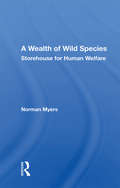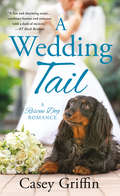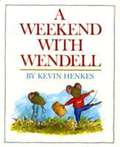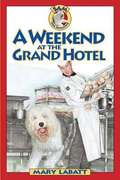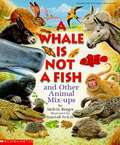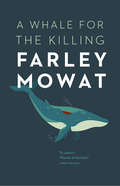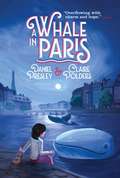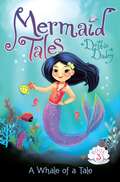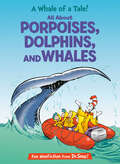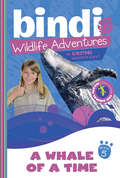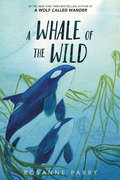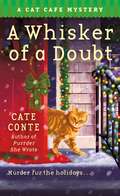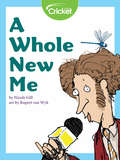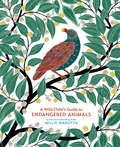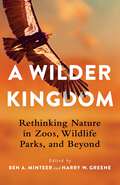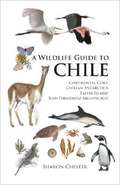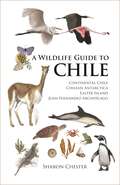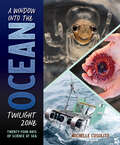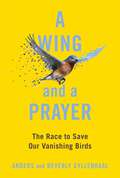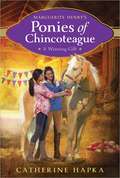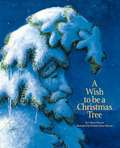- Table View
- List View
A Wealth Of Wild Species: Storehouse For Human Welfare
by Norman MyersThis book tells how our welfare is ever more intimately tied up with the welfare of the millions of species that share the One Earth home with us. It presents a synoptic review of the contributions that wild species make, and can make, to our daily lives.
A Wedding Tail
by Casey Griffin’TIL DEATH DO US BARK… Wedding planner Zoe Plum has brides from all walks of life vying for her services. The only problem is: happily-single Zoe doesn’t actually enjoy weddings—but that might change when she meets the singer of a local band playing at one of her weddings. His name is Levi Dolson and he’s too gorgeous for his own good. And now he’s gone ahead and charmed her new dachshund. . . It’s no secret that Zoe doesn’t believe in fairy tales, but that doesn’t stop her from wanting to make sweet music with Levi. While she’s convinced she doesn’t need a man, when someone starts setting one trap after the next to make sure she never plans a wedding ever again, she might need Levi in more ways than she could have imagined. But just how far is Zoe’s hidden enemy willing to go? The only thing Levi knows for sure is that he will do everything in his power to protect the woman who brings music to his soul. Maybe that will prove to Zoe, once and for all, that he is a man worthy of her heart. . .
A Wedding on Christmas Street
by Ivy Pembroke'Heartwarmingly festive - if only all streets were like Christmas Street!' Ali McNamaraSam is about to propose to his girlfriend Libby, and his neighbours in Christmas Street all think they know the right way to do it. With their help - and sometimes hinderance - Sam gains a fiancée and the wedding planning begins. Meanwhile, Sam's nine-year-old son Teddy and his friend Pari - with their constant companion Jack the street dog - are fascinated by the arrival of a mysterious new neighbour on the street who has rented the empty, run-down house. Their attempts to spy on her are thwarted by her staying indoors with the curtains drawn most of the time. But soon Christmas Street begins to work its magic and Millie is reluctantly drawn into street activities.As Millie starts to relax into thinking she can have a different life, maybe even with Jasper, the local carpenter, someone turns up from her past to threaten that. But with all of the street looking out for her, Millie's Christmas will be filled with hope and promise.
A Wedding on Christmas Street
by Ivy Pembroke'Heartwarmingly festive - if only all streets were like Christmas Street!' Ali McNamaraSam is about to propose to his girlfriend Libby, and his neighbours in Christmas Street all think they know the right way to do it. With their help - and sometimes hinderance - Sam gains a fiancée and the wedding planning begins. Meanwhile, Sam's nine-year-old son Teddy and his friend Pari - with their constant companion Jack the street dog - are fascinated by the arrival of a mysterious new neighbour on the street who has rented the empty, run-down house. Their attempts to spy on her are thwarted by her staying indoors with the curtains drawn most of the time. But soon Christmas Street begins to work its magic and Millie is reluctantly drawn into street activities.As Millie starts to relax into thinking she can have a different life, maybe even with Jasper, the local carpenter, someone turns up from her past to threaten that. But with all of the street looking out for her, Millie's Christmas will be filled with hope and promise.
A Weekend With Wendell
by Kevin HenkesWendell was spending the weekend at Sophie's house. Playing house, Wendell was the mother, the father, and the children; Sophie was the dog. Playing bakery, Wendell was the baker; Sophie got to be the sweet roll. <P><P>Wendell shone his flashlight in Sophie's eyes when she tried to sleep. But when he gave her a new hairdo with shaving cream, it was the last straw, and Sophie made up a game that left Wendell speechless for a time -- and won the day for friendship.
A Weekend at the Grand Hotel
by Mary LabattJoin Sam, Dog Detective, on her fifth funny adventure as she enjoys a little family holiday at the Grand Hotel.And what could be more exciting than the bustling lobby of a big hotel? Guests arrive, people meet -- and signals are exchanged. For Sam, this can mean only one thing: spies, and lots of them! Everyone seems awfully suspicious, what with envelopes being passed back and forth, people creeping out of guests' rooms and secretly using the back stairs. Something's definitely up, and Sam is sure to figure it out -- if only Jennie and Beth will help her.
A Whale Is Not a Fish and Other Animal Mix-ups
by Melvin BergerIs it an alligator . . . or a crocodile? A butterfly . . . or a moth? A donkey . . . or a mule? They might look alike, but they are not! Find out about these and many more animal mix-ups in this fun-to-read book.
A Whale for the Killing
by Farley MowatWhen an 80-ton Fin Whale became trapped in a lagoon near his Newfoundland home, Farley Mowat rejoiced: here was a unique chance to observe one of the world's most magnificent creatures up close. But some of his neighbours saw a different opportunity altogether: in a prolonged fit of violence, they blasted the whale with rifle fire, and scarred its back with motorboat propellers. Mowat appealed desperately to the police, to marine biologists, finally to the Canadian press. But it was too late. Mowat's poignant and compelling story is an eloquent argument for the end of the whale hunt, and the rediscovery of the empathy that makes us human.
A Whale in Paris: How It Happened That Chantal Duprey Befriended A Whale During The Second World War And Helped Liberate France
by Daniel Presley Claire Polders Erin McGuireA hopeful and heroic girl befriends a small, lost whale during World War II and together they embark on a journey to liberate France and find their families in this charming debut novel.Ever since the Germans became the unwelcome “guests” of Paris in the early days of World War II, Papa and Chantal have gone out in the evenings to fish in the Seine. Tonight Chantal is hoping for a salmon, but instead she spies something much more special: a whale! Though small (for a whale) and lost, he seems friendly. Chantal soon opens her heart to the loveable creature and names him Franklin, after the American president who must surely be sending troops to rescue her country. Yet Franklin is in danger: The Parisians are starving and would love to eat him, and the Nazis want to capture him as a gift to Hitler. In a desperate bid to liberate themselves and their city, Chantal and Franklin embark on a dangerous voyage. But can one small girl manage to return a whale to the ocean and reunite him with his parents? And will she ever see her own family again?
A Whale in the Bathtub
by Kylie Westaway Tom JellettBruno! It's bath time! But there’s a whale in the bathtub—a huge, tub-hogging, bubble-bath-squirting, flipper-scrubbing, barnacle-rinsing whale! Worse yet, no one believes Bruno when he says the tub is full. The whale refuses to budge. How will Bruno ever get clean?
A Whale of a Tale
by Debbie Dadey Tatevik AvakyanIn this sparkling Mermaid Tales adventure, can Kiki overcome her fears and enjoy her first-ever trip to the ocean's surface? The third graders at Trident Academy are traveling to the surface of the ocean for the first time ever for a "hugely" exciting activity: They're going to visit a pod of humpback whales! But Kiki is less than thrilled. In fact, she's scared from the top of her head to the tip of her tail. After all, the enormous creatures could swallow her (and maybe her entire class) in one giant gulp! Kiki's pals Shelly and Echo try to help shrink her fears, and when a new friend comes along--a very big, whale-size friend--Kiki's courage emerges, and the fun looms large.
A Whale of a Tale! All About Porpoises, Dolphins, and Whales: All About Porpoises, Dolphins, and Whales (The Cat in the Hat's Learning Library)
by Bonnie WorthLaugh and learn with fun facts about whales, porpoises, dolphins, and more—all told in Dr. Seuss&’s beloved rhyming style and starring the Cat in the Hat! &“What&’s the story today? Funny that you should ask. We&’re going to take on a whale of a task!&” The Cat in the Hat&’s Learning Library series combines beloved characters, engaging rhymes, and Seussian illustrations to introduce children to non-fiction topics from the real world! Go under the sea and discover: • what a cetacean is• how to tell dolphins and porpoises apart• how whales &“talk&” to one another• and much more! Perfect for story time and for the youngest readers, A Whale of a Tale! All About Porpoises, Dolphins, and Whales also includes an index, glossary, and suggestions for further learning. Look for more books in the Cat in the Hat&’s Learning Library series!If I Ran the Horse Show: All About HorsesClam-I-Am! All About the BeachMiles and Miles of Reptiles: All About ReptilesSafari, So Good! All About African WildlifeThere's a Map on My Lap! All About MapsOh, the Lavas That Flow! All About VolcanoesOut of Sight Till Tonight! All About Nocturnal AnimalsWhat Cat Is That? All About CatsOnce upon a Mastodon: All About Prehistoric MammalsOh Say Can You Say What's the Weather Today? All About WeatherThe Cat on the Mat: All About Mindfulness
A Whale of a Time
by Bindi Irwin Chris KunzA fast-paced adventure series featuring the Jungle Girl herself! The stories are inspired and co-created by Bindi Irwin, daughter of the iconic wildlife expert Steve Irwin. The series features the characters of Bindi, her brother Robert, mother Terri, and the Australia Zoo. Bindi takes a pair of troublesome English twins out for the whale-watching trip of a lifetime. But when they race to the scene of a boating accident, they discover an oil spill that could endanger marine life for hundreds of miles!
A Whale of the Wild
by Rosanne ParryIn the stand-alone companion to the New York Times–bestselling A Wolf Called Wander, a young orca whale must lead her brother on a tumultuous journey to be reunited with their pod. This gorgeously illustrated animal adventure novel explores family bonds, survival, global warming, and a changing seascape. Includes information about orcas and their habitats. For Vega and her family, salmon is life. And Vega is learning to be a salmon finder, preparing for the day when she will be her family’s matriarch. But then she and her brother Deneb are separated from their pod when a devastating earthquake and tsunami render the seascape unrecognizable. Vega must use every skill she has to lead her brother back to their family. The young orcas face a shark attack, hunger, the deep ocean, and polluted waters on their journey. Will Vega become the leader she’s destined to be? A Whale of the Wild weaves a heart-stopping tale of survival with impeccable research on a delicate ecosystem and threats to marine life. New York Times-bestselling author Rosanne Parry’s fluid writing and Lindsay Moore’s stunning artwork bring the Salish Sea and its inhabitants to vivid life. An excellent read-aloud and read-alone, this companion to A Wolf Called Wander will captivate fans of The One and Only Ivan and Pax. Includes black-and-white illustrations throughout, a map, and extensive backmatter about orcas and their habitats.
A Whisker of a Doubt (Cat Cafe Mystery Series #4)
by Cate ConteIt's promising to be a picture-purrfect Christmas at New England's favorite cat cafe . . . but instead of jolly old St. Nick, residents are being visited by murder. The fourth in a mystery series from author Cate Conte, A Whisker of a Doubt is filled with felines and crime. <p><p> The holiday season on Daybreak Island is a mixed bag for Maddie James. On the one hand, her Christmas spirit is in the doghouse after a break-up. On the other, she’s busy enough that she doesn’t have to pretend to be merry. Business at her cat café is booming, and Maddie’s care-taking of a feral cat colony in one of the area’s wealthiest communities only helps her bottom line. But tensions between the homeowners and animal activists are escalating to catastrophic levels. . .and before long a body is found dead in a snowbank. To prove that her accused friend is innocent of the crime, Maddie will have to prowl the island for clues to the real killer before everyone on the island goes completely hiss-terical—and more than nine lives are lost.
A Whole New Me
by Nicole GillMany insects and amphibians change shape—or metamorph—completely. Why do they do it?
A Wild Child's Guide to Endangered Animals
by Millie MarottaFrom New York Times bestselling author Millie Marotta comes this gorgeous celebration of the animal kingdom. A Wild Child's Guide to Endangered Animals highlights the plight of 43 endangered species from around the world, including rare and well-known animals living in freshwater, oceans, forests, mountains, tundras, deserts, grasslands, and wetlands. Vivid illustrations bring caribous, axolotls, giraffes, agami herons, and many more to life on these rich and varied pages. Illuminating text relays the story of each species, from how they live and why they are endangered to what is being done about it. Complete with a map detailing where each species can still be found, this visually rich, timely, informative book raises awareness in the most spectacular way.
A Wild Experiment (Fountas & Pinnell Classroom, Guided Reading)
by Mia LewisNIMAC-sourced textbook. ASTONISHING. Decades after wolves disappeared from Yellowstone National Park, scientists decided to try a bold experiment. They released a group of wild wolves into the park and waited anxiously to see what would happen. The results went beyond their wildest expectations.
A Wilder Kingdom: Rethinking Nature in Zoos, Wildlife Parks, and Beyond
by Ben A. Minteer and Harry W. GreeneZoos have always had a troubled relationship to what is considered the “real” wild. Even the most immersive and naturalistic zoos, critics maintain, are inherently contrived and inauthentic environments. Zoo animals’ diet, care, and reproduction are under pervasive human control, with natural phenomena like disease and death kept mostly hidden from public view. Furthermore, despite their growing commitment to conservation and education, zoos are entertainment providers that respond to visitors’ expectations and preferences. What would a “wilder” zoo—one that shows the public a wider range of ecological processes—look like? Is it achievable or even desirable? What roles can or should zoos play in encouraging humanity to find meaningful connections with wild animals and places?A Wilder Kingdom is a provocative and reflective examination of the relationship between zoos and the wild. It gathers a premier set of multidisciplinary voices—from animal studies and psychology to evolutionary biology and environmental journalism—to consider the possibilities and challenges of making zoos wilder. In so doing, the contributors offer new insights into the future of the wild beyond zoos and our relationship to wild species and places across the landscape in an increasingly human-dominated era.
A Wildlife Guide to Chile
by Sharon Chester"There is an embarrassment of riches in field guides, but truly novel approaches are rare. Sharon Chester's "Wildlife Guide to Chile" is one of the few books that stand out by virtue of their content, organization, and comprehensiveness. In a single, portable volume, Chester presents nearly every natural gem that Chile has to offer--richly illustrated, tersely described, and, in many cases, presented for the very first time in any field guide. Naturalists everywhere will recognize Chester's dedication to this project; travelers to Chile will simply gush with appreciation. "--Edward S. Brinkley, editor-in-chief of the journal "North American Birds"
A Wildlife Guide to Chile: Continental Chile, Chilean Antarctica, Easter Island, Juan Fernández Archipelago
by Sharon ChesterThis is the first comprehensive English-language field guide to the wildlife of Chile and its territories--Chilean Antarctica, Easter Island, Juan Fernández, and San Félix y San Ambrosio. From bats to butterflies, lizards to llamas, and ferns to flamingos, A Wildlife Guide to Chile covers the country's common plants and animals. The color plates depict species in their natural environments with unmatched vividness and realism. The combination of detailed illustrations and engaging, succinct, and authoritative text make field identification quick, easy, and accurate. Maps, charts, and diagrams provide information about landforms, submarine topography, marine environment, climate, vegetation zones, and the best places to view wildlife. This is an essential guide to Chile's remarkable biodiversity. The only comprehensive English-language guide to Chile's common flora and fauna The first guide to cover Chile and its territories--Chilean Antarctica, Easter Island, Juan Fernández, and San Félix y San Ambrosio 120 full-color plates allow quick identification of more than 800 species Accompanying text describes species size, shape, color, habitat, and range Descriptions list size, distribution, and English, Spanish, and scientific names Information on the best spots to view wildlife, including major national parks Compact and lightweight--a perfect field guide
A Window into the Ocean Twilight Zone: Twenty-Four Days of Science at Sea
by Michelle CusolitoWant a front-row seat to cutting-edge ocean twilight zone technology? Climb aboard for twenty-four days of photo-illustrated science at sea! A fascinating middle-grade STEM book.Join scientists from Woods Hole Oceanographic Institution (WHOI) and international partner organizations on a research trip to study the ocean twilight zone using the newest technologies. Science writer Michelle Cusolito takes you along for the voyage of a lifetime. From moving onto the ship and unpacking equipment to facing massive storms while in the middle of the Atlantic Ocean, this book details the fascinating equipment used to study the deep ocean as well as day-to-day details such as what you eat on a Spanish research ship. Meet people and animals and learn more at sea than you ever imagined!&“From word one, Cusolito puts the reader smack into the action. Captivating creatures abound, coupled with important insights that impact our understanding of the ocean&’s role in our planet&’s sustainability. Perfectly titled, this book throws a window wide open, giving us an intimate look into the twilight zone.&” —Tanya Lee Stone, Sibert Medalist & NAACP Image Award Winner&“Michelle Cusolito captures the essence of high-seas research in A Window into the Ocean Twilight Zone. She skillfully guides the reader through what it&’s like to be a scientist at sea—the anticipation of departure, the challenges of heavy weather, and the thrill of discovery in one of the ocean&’s most remote and mysterious regions. In the process, she underscores the urgency behind advancing knowledge of Earth&’s last frontier—the ocean.&”—Peter de Menocal, President and Director of the Woods Hole Oceanographic Institution&“This spellbinding, real-life adventure will whisk you away with a team of scientists as they explore the wonders of the twilight zone. Michelle is a perfect guide to this remote realm and brilliantly shows what it's like to be a scientist working in challenging conditions. You&’ll learn about the importance of teamwork and patience, find out about the exciting technologies scientists use to study the deep sea, and see how discoveries about our living planet are made. This book will spark curiosity and is perfect for budding scientists.&”—Dr. Helen Scales, marine biologist and author of books for kids and adults, including What a Shell Can Tell and The Brilliant Abyss
A Wing and a Prayer: The Race to Save Our Vanishing Birds
by Anders Gyllenhaal Beverly GyllenhaalA captivating drama from the frontlines of the race to save birds set against the devastating loss of one third of the avian population. Three years ago, headlines delivered shocking news: nearly three billion birds in North America have vanished over the past fifty years. No species has been spared, from the most delicate jeweled hummingbirds to scrappy black crows, from a rainbow of warblers to common birds such as owls and sparrows. In a desperate race against time, scientists, conservationists, birders, wildlife officers, and philanthropists are scrambling to halt the collapse of species with bold, experimental, and sometimes risky rescue missions. High in the mountains of Hawaii, biologists are about to release clouds of laboratory-bred mosquitos in a last-ditch attempt to save Hawaii&’s remaining native forest birds. In Central Florida, researchers have found a way to hatch Florida Grasshopper Sparrows in captivity to rebuild a species down to its last two dozen birds. In the Sierra Nevada Mountains, a team is using artificial intelligence to save the California Spotted Owl. In North Carolina, a scientist is experimenting with genomics borrowed from human medicine to bring the long-extinct Passenger Pigeon back to life. For the past year, veteran journalists Anders and Beverly Gyllenhaal traveled more than 25,000 miles across the Americas, chronicling costly experiments, contentious politics, and new technologies to save our beloved birds from the brink of extinction. Through this compelling drama, A Wing and a Prayer offers hope and an urgent call to action: Birds are dying at an unprecedented pace. But there are encouraging breakthroughs across the hemisphere and still time to change course, if we act quickly.
A Winning Gift
by Catherine HapkaMaddie worries she might be giving up too much--especially Cloudy, her pony--in this fifth book in a contemporary middle grade series in the tradition of Marguerite Henry's Misty of Chincoteague.It's almost Maddie's birthday, and while snooping around for her hidden gifts (a family tradition), she stumbles across something that makes her think her mother is getting transferred again by the Air Force--this time overseas! Oh, no! What will that mean for Maddie and her pony, Cloudy? On top of that Maddie's best friend Bridget has just broken up with her boyfriend, and it seems that Cloudy is the only thing that makes her feel better. Why does Maddie always have to be the one who's making sacrifices?
A Wish To Be a Christmas Tree
by Colleen MonroeFeeling sad because no one chooses it as a Christmas tree, a bedraggled forest pine discovers the importance of being appreciated all year long. A Wish to be a Christmas Tree has become a holiday favorite of children and adults alike. When a towering evergreen realizes he is much too big to ever be chosen as a family's Christmas tree he is heartbroken. But his forest friends remind him what a gift he is to them every day of the year. The story captures the true spirit of the holiday--and has been capturing the imagination of readers since its publication. Fans include Katie Couric, who read the book on the Today show's Christmas day airing, and Mitch Albom (author of The First Phone Call from Heaven). who narrated an animated special of A Wish to be a Christmas Tree for PBS. Pictures are described.
